
Solar thermal energy (STE) is a form of energy and a technology for harnessing solar energy to generate thermal energy for use in industry, and in the residential and commercial sectors. Solar thermal collectors are classified by the United States Energy Information Administration as low-, medium-, or high-temperature collectors. Low-temperature collectors are generally unglazed and used to heat swimming pools or to heat ventilation air. Medium-temperature collectors are also usually flat plates but are used for heating water or air for residential and commercial use.
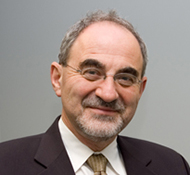
Eli Yablonovitch is an American physicist and engineer who, along with Sajeev John, founded the field of photonic crystals in 1987. He and his team were the first to create a 3-dimensional structure that exhibited a full photonic bandgap, which has been named Yablonovite. In addition to pioneering photonic crystals, he was the first to recognize that a strained quantum-well laser has a significantly reduced threshold current compared to its unstrained counterpart. This is now employed in the majority of semiconductor lasers fabricated throughout the world. His seminal paper reporting inhibited spontaneous emission in photonic crystals is among the most highly cited papers in physics and engineering.

The Institute for Nuclear Studies was founded September 1945 as part of the University of Chicago with Samuel King Allison as director. On November 20, 1955, it was renamed The Enrico Fermi Institute for Nuclear Studies. The name was shortened to The Enrico Fermi Institute (EFI) in January 1968.
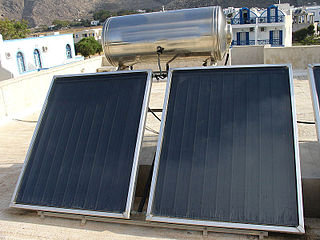
A solar thermal collector collects heat by absorbing sunlight. The term "solar collector" commonly refers to a device for solar hot water heating, but may refer to large power generating installations such as solar parabolic troughs and solar towers or non-water heating devices such as solar cookers or solar air heaters.
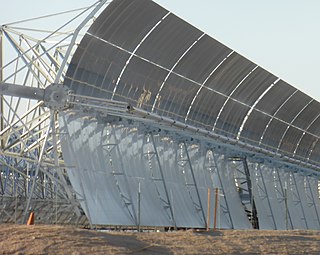
A parabolic trough collector (PTC) is a type of solar thermal collector that is straight in one dimension and curved as a parabola in the other two, lined with a polished metal mirror. The sunlight which enters the mirror parallel to its plane of symmetry is focused along the focal line, where objects are positioned that are intended to be heated. In a solar cooker, for example, food is placed at the focal line of a trough, which is cooked when the trough is aimed so the Sun is in its plane of symmetry.
Nonimaging optics is a branch of optics that is concerned with the optimal transfer of light radiation between a source and a target. Unlike traditional imaging optics, the techniques involved do not attempt to form an image of the source; instead an optimized optical system for optimal radiative transfer from a source to a target is desired.

A solar tracker is a device that orients a payload toward the Sun. Payloads are usually solar panels, parabolic troughs, Fresnel reflectors, lenses, or the mirrors of a heliostat.

Light tubes are structures that transmit or distribute natural or artificial light for the purpose of illumination and are examples of optical waveguides.

Concentrated solar power systems generate solar power by using mirrors or lenses to concentrate a large area of sunlight into a receiver. Electricity is generated when the concentrated light is converted to heat, which drives a heat engine connected to an electrical power generator or powers a thermochemical reaction.
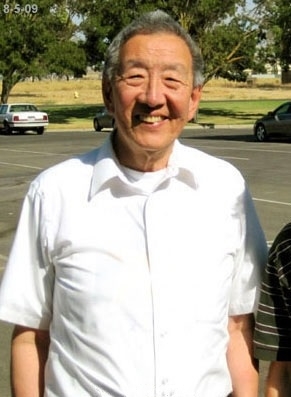
Raymond Y. Chiao is an American physicist best known for his experimental work in quantum optics. He is currently an emeritus faculty member at the University of California, Merced physics department, where he is conducting research on gravitational radiation in collaboration with Prof. Jay Sharping.
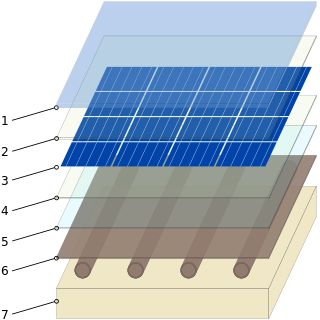
Photovoltaic thermal collectors, typically abbreviated as PVT collectors and also known as hybrid solar collectors, photovoltaic thermal solar collectors, PV/T collectors or solar cogeneration systems, are power generation technologies that convert solar radiation into usable thermal and electrical energy. PVT collectors combine photovoltaic solar cells, which convert sunlight into electricity, with a solar thermal collector, which transfers the otherwise unused waste heat from the PV module to a heat transfer fluid. By combining electricity and heat generation within the same component, these technologies can reach a higher overall efficiency than solar photovoltaic (PV) or solar thermal (T) alone.
A compact linear Fresnel reflector (CLFR) – also referred to as a concentrating linear Fresnel reflector – is a specific type of linear Fresnel reflector (LFR) technology. They are named for their similarity to a Fresnel lens, in which many small, thin lens fragments are combined to simulate a much thicker simple lens. These mirrors are capable of concentrating the sun's energy to approximately 30 times its normal intensity.
A solar-pumped laser is a laser that shares the same optical properties as conventional lasers such as emitting a beam consisting of coherent electromagnetic radiation which can reach high power, but which uses solar radiation for pumping the lasing medium. This type of laser is unique from other types in that it does not require any artificial energy source.

Anidolic lighting systems use anidolic optical components to light rooms. Light redirected by these systems does not converge to a focal point or form an image, hence the name.
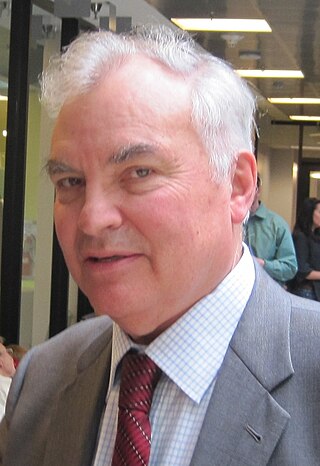
Don P. Moon is an American academic administrator, minister, and former nuclear reactor physicist. He was the president of Shimer College from 1978 to 2004, and has been on the faculty of Shimer College since 1967.
A Winston cone is a non-imaging light collector in the shape of an off-axis parabola of revolution with a reflective inner surface. It concentrates the light passing through a relatively large entrance aperture through a smaller exit aperture. The collection of incoming rays is maximized by allowing off-axis rays to make multiple reflections before reaching the exit aperture. Winston cones are used to concentrate light from a large area onto a smaller photodetector or photomultiplier. They are widely used for measurements in the far infrared portion of the electromagnetic spectrum in part because there are no suitable materials to form lenses in the range.
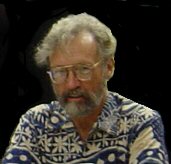
Bill Parkyn was an American scientist who lived in Lomita, California area and worked on nonimaging optics.
Photopia Optical Design Software (Photopia) is a commercial optical engineering ray-tracing software program for the design and analysis of non-imaging optical systems. Photopia is written and distributed by LTI Optics, LLC and was first released in 1996. Photopia's main market is the architectural lighting industry but it is also used in the automotive, medical, industrial, signal and consumer products industries. Photopia includes a full library of lamps including the latest high brightness LEDs as well as a library of material BSDF data.
Walter Thompson Welford was a British physicist with expertise in optics.

Jean-Louis Scartezzini is a Swiss building physicist specialized in day lighting and solar buildings. He is a professor of physics at EPFL and the head of the Solar Energy and Building Physics Laboratory (LESO-PB) since 1994.












